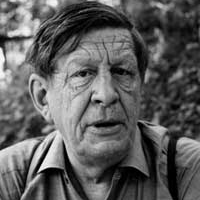Musee des Beaux Arts by W.H. Auden: Summary and Analysis
This fine lyrical poem, Musee des Beaux Arts, is one of Auden's most celebrated short poems. It was first published in 1939, though written by Auden during his winter sojourn in Brussels in 1938. Auden begins the lyric by praising the painters of old, like Brueghel, who understood the nature of suffering and humanity’s indifference to it. This fact is well-illustrated by a number of paintings of the famous painter of Flanders.

W.H. Auden (1907-1973)
His painting shows that he realized that while individuals suffer, the daily routine of life goes on as usual undisturbed. People eat and drink and enjoy, the dogs continue to live their lives as usual, and children continue to play unconcerned even in the midst of such a great tragedy as the crucifixion of Christ.
Some devout, religious minded people may care for Christ, but humanity as a whole is not much interested either in the birth of Christ or his crucifixion. This general indifference is clearly brought out by two paintings of Breughel, one depicting the birth of Christ or his crucifixion. This general indifference is clearly brought out by two paintings of Breughel, one depicting the birth of Christ, and the other his crucifixion. In the later painting as Christ is crucified, the crucifier’s horse goes on rubbing his behind against a tree, totally unconcerned with the great tragedy.
A third picture of Brueghel entitled Icarus brings out this indifference even more vividly. It shows Icarus falling from the sky into the sea, farmers hearing the great splash, turning to see what the matter was, and then turning once again to their work entirely at ease and undisturbed. The great disaster is also observed by the crew of a ship at sea. They are much amazed to see a boy falling from the sky, and then only two white legs rising out of the sea. This amazement is their only response to the disaster. No effort is made to rescue the fallen boy. The ship sails on unconcerned. The paintings fully bring out the indifference of humanity to individual suffering. It is taken as a matter of routine. This is the moral Auden has been able to draw from the painted scenery. Critics have taken the poem as a satire on the callous indifference to suffering of the modern humanity. However, it should be noted that Auden has universalized the truth by referring to the imagery of Brueghel’s paintings. Humanity was indifferent to the suffering of others in ancient times when Icarus fell, it was indifferent at a later date when Christ was crucified, and it is also equally indifferent today. Thus, the imagery of the paintings has been used as, "objective correlative" to universalize the human condition.
The poem Musee des Beaux Arts, which means ‘Museum of Fine Arts’ in French, is a poem W.H. Auden composed after he visited that museum in Paris. The poem is a reflection (meditation) on the old paintings which depict life’s reality strikingly. Auden mentions three of the paintings which show the place of suffering in human life. Disasters, tragedies and sufferings are a part of life; they happen any time. But life has to go on. The poem also indirectly shows human beings' indifference towards their fellow beings. The poem begins and ends with meditation. The description in the middle is also in an ordinary language and rhythm. The poem is symbolic at places.
Auden praises the painters, like Brueghel, who understood the nature of suffering and humanity’s indifference to it. This fact is well-illustrated by a number of paintings of the famous painter. The paintings fully bring out the indifference of humanity to individual suffering. It is taken as a matter of routine. This is the moral Auden has been able to draw from the painted scenery. Critics have taken the poem as a satire on the soulless indifference to suffering of the modern humanity. However, it should be noted that Auden has universalized the truth by referring to the imagery of Brueghel’s paintings. Humanity was indifferent to the suffering of others in ancient times when Icarus fell, it was indifferent at a later date when Christ was crucified and it is also equally indifferent today. This is an irony, but this is also the reality of life. Whether we cry and panic or not, tragedies will happen and life will still have to go on. The tone of the poem is easy and conversational. It is as if the poet were talking aloud to himself, or to some intimate friend.
It is not easy to say whether the poet has intended to satirize human beings' indifference towards another. We are sometimes ignorant and blind to others' pain, like the horse. Sometimes we say not fully understand, like the children near the pond. As experienced people, we have learnt to be indifferent like the farmer or the people in the ship. We have lost sympathy and understanding due to habit. We are ‘delicate’ and vulnerable ourselves like the ship in the sea. But so far as it happens to others, we cast the same look upon everything, like the sun that shines equally upon pain or pleasure. But, this is the reality. Our grumbling will not correct human nature. And at least some amount of this indifference will be necessary for us to bear the sufferings. Without any indifference at all, life would be unbearable.
The poem is simple in its language. Its description is the basis for meditation, which is the poem’s theme. The speaker tells everything he feels. The language is simple. The tone and tempo (speed) creates the appropriate mood for the serious theme. The poem is unforgettable in its imagery.
Cite this Page!
Sharma, Kedar N. "Musee des Beaux Arts by W.H. Auden: Summary and Analysis." BachelorandMaster, 19 Nov. 2013, bachelorandmaster.com/britishandamericanpoetry/musee-des-beaux-arts.html.
